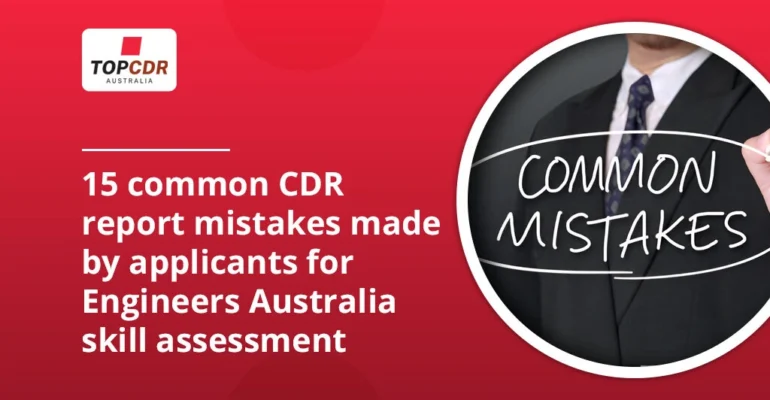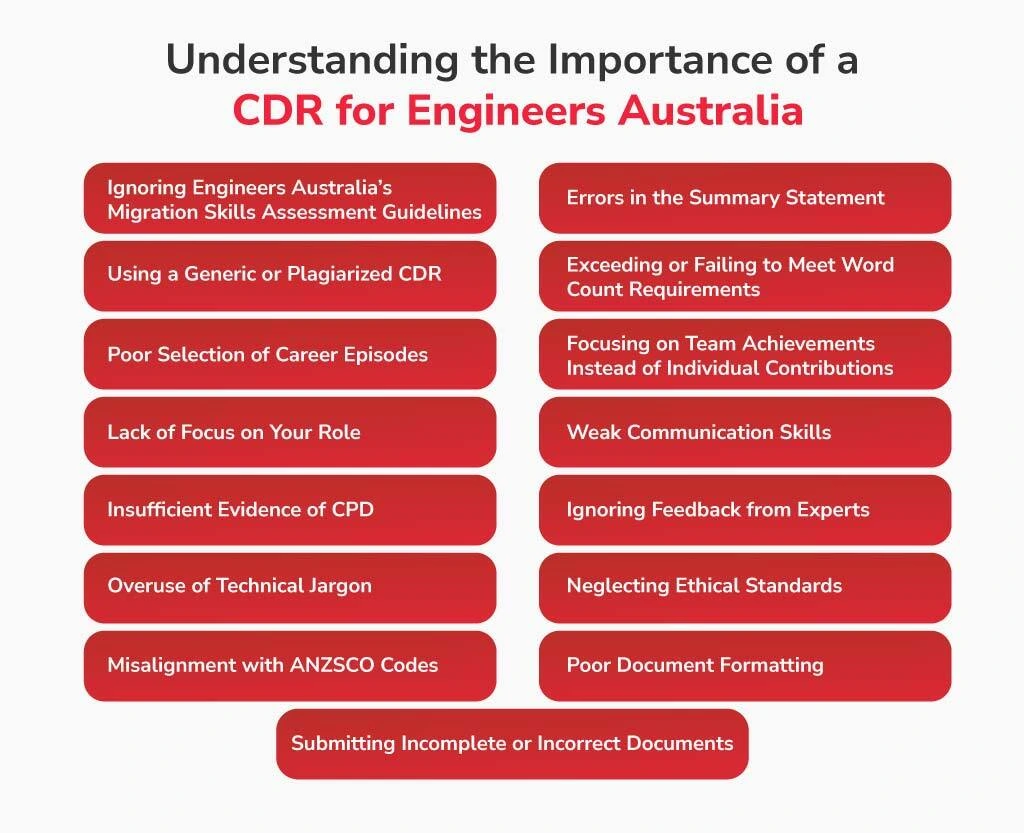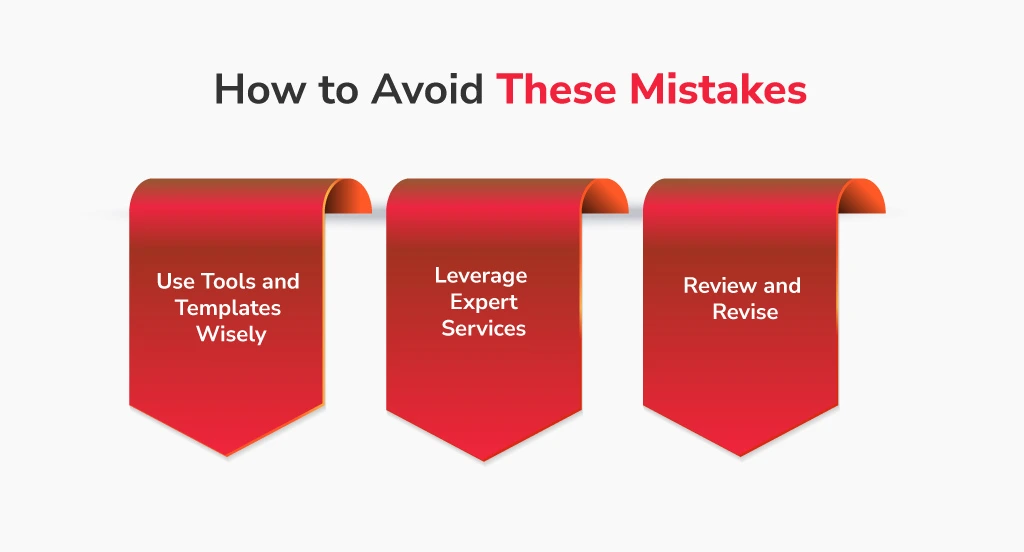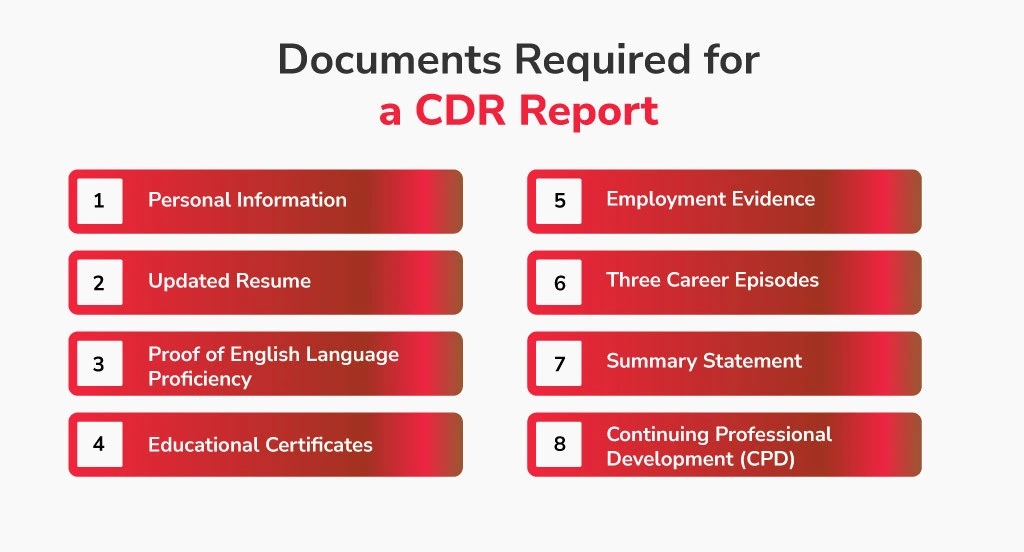15 common CDR report mistakes made by applicants for Engineers Australia skill assessment

15 common CDR report mistakes made by applicants for Engineers Australia skill assessment
Preparing a Competency Demonstration Report (CDR) for Engineers Australia is a meticulous process that demands attention to detail, technical accuracy, and adherence to specific guidelines.
This document is critical for obtaining a positive skill assessment for Engineers Australia, enabling engineers to pursue migration and professional opportunities in Australia. However, many applicants make avoidable mistakes that jeopardise their chances of success.
In this comprehensive blog, we’ll explore 15 common CDR report mistakes, explain their implications, and provide tips to help you avoid them.
Understanding the Importance of a CDR for Engineers Australia

A CDR is a technical report that demonstrates your engineering competencies as per Engineers Australia’s standards. It includes three career episodes, a summary statement, and a continuing professional development (CPD) document.
Errors in any section can lead to rejection or requests for revisions, delaying the assessment process. Let’s delve into the most common mistakes applicants make and how you can avoid them.
1. Ignoring Engineers Australia’s Migration Skills Assessment Guidelines
Engineers Australia provides clear instructions for CDR preparation. Failing to follow these guidelines is one of the biggest reasons for rejection.
For this problem, thoroughly read the Migration Skills Assessment booklet and adhere to its formatting, language, and structural requirements, focusing on demonstrating your competencies through projects and achievements aligned with the required skill levels.
2. Using a Generic or Plagiarized CDR
Submitting copied content or overly generic career episodes can result in outright rejection. Engineers Australia employs advanced plagiarism detection tools.
For this problem, write original content personalised to your engineering experience. Avoid templates from unverified sources and use plagiarism-checking tools to validate originality before submission.
a. Plagiarism
Copying content from existing CDR samples or online resources can lead to immediate rejection. Engineers Australia (EA) employs advanced plagiarism detection tools, and any similarity to published content is easily caught.
Solution: Write your report in your own words, using available resources only as a reference to guide your ideas. Ensure that your content reflects your experiences and professional expertise authentically.
b. Grammatical and Spelling Errors
Errors in grammar, spelling, or punctuation can make your CDR appear unprofessional.
Solution: Proofread your report carefully and use language tools to check for errors. Alternatively, have your report reviewed by a professional editor or a native English speaker to ensure clarity and accuracy.
c. Formatting Issues
Improper formatting can lead to confusion and reduce the readability of your report.
Solution: Follow the structure outlined by Engineers Australia, using paragraphs instead of bullet points. Stick to the recommended templates and guidelines.
3. Poor Selection of Career Episodes
Choosing career episodes unrelated to your engineering field or lacking complexity undermines your application.
For this problem, pick projects that highlight your problem-solving skills, technical knowledge, and leadership abilities, ensuring each episode addresses specific competencies outlined in the Engineers Australia guidelines.
4. Lack of Focus on Your Role
Failing to emphasize your contributions and responsibilities in projects makes it difficult for assessors to gauge your competencies.
For this problem, clearly define your role in each career episode. Use active language to describe your tasks and achievements.
5. Insufficient Evidence of CPD
Neglecting to provide detailed Continuing Professional Development (CPD) records shows a lack of commitment to your professional growth.
For this problem, include a well-organized CPD document listing relevant workshops, certifications, and training programs and use a chronological format for clarity.
6. Overuse of Technical Jargon
While technical expertise is crucial, excessive use of technical terms can make your report difficult to read.
For this problem, balance technical details with clear and concise explanations. Assume the assessor is not familiar with specific terminologies.
7. Misalignment with ANZSCO Codes
Choosing an incorrect ANZSCO code can lead to a mismatch between your skills and Engineers Australia’s requirements.
For this problem, select an ANZSCO code that aligns with your qualifications and experience on the list of ANZSCO unit groups on Engineers Australia’s website. Ensure your career episodes reflect this alignment.
8. Errors in the Summary Statement
The summary statement is crucial as it links your career episodes to Engineers Australia’s competency elements. Errors or omissions here are detrimental.
For this problem, carefully map each competency element to the relevant sections of your career episodes. Cross-check for accuracy.
9. Exceeding or Failing to Meet Word Count Requirements
Too lengthy or too brief career episodes often result in rejection.
For this problem, adhere to the word count limits specified by Engineers Australia. Typically, each career episode should be between 1,000 and 2,500 words.
10. Focusing on Team Achievements Instead of Individual Contributions
Assessors are interested in your role, not the collective achievements of your team.
For this problem, emphasize your personal contributions, decisions, and problem-solving skills in projects.
Use “I” statements to emphasize your contributions and highlight the challenges you addressed, the decisions you made, and the outcomes you achieved.
11. Weak Communication Skills
Using improper grammar, poor sentence structures, or unclear language can diminish the impact of your CDR.
For this problem, write in professional and error-free English. Use tools like Grammarly or hire professional editing services.
12. Ignoring Feedback from Experts
Many applicants skip professional reviews of their CDR, leading to preventable errors.
For this problem, seek professional guidance or have your report reviewed by an expert familiar with Engineers Australia’s requirements.
13. Neglecting Ethical Standards
Exaggerating achievements or providing misleading information is unethical and can result in a ban.
For this problem, be truthful and transparent in your CDR. Provide accurate data and real-life examples.
14. Poor Document Formatting
Sloppy formatting can make your CDR look unprofessional and difficult to follow.
For this problem, use a clean and consistent format. Follow Engineers Australia’s layout and presentation guidelines. Use headings, subheadings, and bullet points for better organisation.
15. Submitting Incomplete or Incorrect Documents
Incomplete submissions or errors in supporting documents can delay the skill assessment process.
For this problem, double-check all required documents, including your CDR, educational transcripts, and reference letters, before submission.
a. Lack of Sufficient Details
Failure to provide enough detail about your projects or experiences can weaken your report.
Solution: Choose projects that align with your educational background and professional expertise. Clearly outline the project’s purpose, your role, and the outcomes.
b. False or Misleading Information
Including exaggerated or false details about your projects, qualifications, or experiences can lead to rejection and even a ban from future assessments.
Solution: Be truthful and ensure all the information provided is accurate and verifiable.
How to Avoid These Mistakes

To prepare a flawless CDR, you must invest time and effort into understanding Engineers Australia’s expectations. Here are some tips:
- Use Tools and Templates Wisely
Avoid using free online templates without proper verification.
- Leverage Expert Services
If you’re unsure, consult professionals specialising in CDR writing.
- Review and Revise
Proofread multiple times to catch errors or inconsistencies.
Documents Required for a CDR Report

To successfully prepare a CDR report for Engineers Australia, several key documents are required. These include:
- Personal Information
A copy of your birth certificate and the biodata page of your passport.
- Updated Resume
A detailed resume that outlines your professional experience and educational background.
- Proof of English Language Proficiency
Valid test results from accepted English proficiency tests.
- Educational Certificates
This includes academic transcripts, enrollment documents, and relevant degree certificates.
- Employment Evidence
Work reference letters or employment verification documents.
- Three Career Episodes
Detailed narratives that highlight your engineering experience and achievements.
- Summary Statement
A concise summary linking your career episodes to Engineers Australia’s competency standards.
- Continuing Professional Development (CPD)
A record of your ongoing learning activities, including workshops, training, and seminars.
Conclusion
A Competency Demonstration Report (CDR) is your gateway to securing skilled migration to Australia. For engineers working abroad, it presents a unique opportunity to build a successful career in Australia.
However, minor mistakes, often caused by negligence or overconfidence, can lead to the rejection of your CDR. With countless engineers vying for Australian immigration, the competition is intense and more challenging than you might anticipate.
But there’s no need to worry. By avoiding these 15 common mistakes outlined above and following practical tips, guidelines, and advice, you can create an exceptional CDR report. Additionally, reviewing well-prepared CDR samples can provide valuable insights into structuring your report.
At TopCDRAustralia, we are dedicated to assisting you with all aspects of your skills assessment. Our CDR preparation services adhere to the guidelines and standards set by Engineers Australia, ensuring that your report meets the required benchmarks for skilled migration.
Whether it’s choosing the right career episodes, writing a strong summary statement, or aligning your CDR with ANZSCO codes, each step plays a vital role in showcasing your engineering competencies.
By following the tips outlined in this blog and ensuring your CDR reflects your unique skills and experiences, you can achieve a positive outcome in your Engineers Australia skills assessment.
With our expertise, up-to-date knowledge of Australian professional migration, and commitment to delivering top-quality services, we are here to support you in achieving your goals. Give our services a try and take the first step toward a successful engineering career in Australia!
Learn more: ACS RPL Preparation Guide: Resources, Challenges, Pathways. 🔥❤️🔥💥
FAQs
1) What are the Common Mistakes to Avoid in CDR Writing?
- Plagiarism
Always write original content; EA strictly disapproves of copied material.
- Grammatical Errors
Proofread thoroughly to avoid language mistakes.
- Incorrect Formatting
Follow EA guidelines for structure and presentation.
- Insufficient Details
Provide complete, accurate, and relevant project information.
- Overloading Technical Jargon
Be clear and concise; avoid excessive complexity.
- Weak Career Episodes
Focus on your contributions, not the team’s efforts.
- Ignoring Word Limits
Stick to the 1,000–2,500 word range for career episodes.
- Missing Problem Statements
Clearly describe challenges and solutions in each project.
- Non-English Submissions
Use Australian English for all documents.
- Weak Summary Statement
Map your skills to EA’s competency standards.
- Irrelevant CPD
Include only relevant professional development activities.
- Poor Project Selection
Choose projects that showcase your skills and expertise.
- Duplicate Project Use
Avoid splitting one project into multiple career episodes.
- Lack of Innovation
Highlight creative solutions and technical designs.
- Neglecting EA Guidelines
Always adhere to EA’s requirements.
2) How to Avoid Common Mistakes in CDR Writing?
- Understand EA Guidelines
Familiarize yourself with Engineers Australia’s (EA) requirements and format before starting.
- Write Original Content
Avoid copying content from samples; focus on showcasing your unique experiences and skills.
- Choose Relevant Projects
Select projects that demonstrate your engineering competencies effectively.
- Proofread Thoroughly
Review your report multiple times to eliminate grammar, spelling, and formatting errors.
- Focus on Your Role
Highlight your contributions rather than the team’s efforts in career episodes.
- Be Concise and Clear
Avoid overly technical jargon and keep descriptions simple and focused.
- Use Australian English
Ensure all documentation adheres to Australian English standards.
- Highlight Problem-Solving Skills
Clearly outline the challenges, your strategies, and the outcomes of your projects.
- Follow Word Limits
Stick to the prescribed word count of 1,000–2,500 words per career episode.
- Align with EA Standards
Map your competencies to the elements listed in EA’s Migration Skills Assessment Booklet.
3) Time Required to Compose a Standard CDR Report.
The time needed to prepare a Competency Demonstration Report (CDR) depends on various factors, including the complexity of the projects, your familiarity with Engineers Australia’s requirements, and your writing skills. On average, the process can take:
- Research and preparation (3-5 days)
- Understanding EA guidelines.
- Choosing relevant projects and gathering supporting documents.
- Writing Career Episodes (5-10 Days)
- Write three career episodes, each tailored to highlight your competencies.
- Highlighting personal contributions, technical skills, and problem-solving abilities.
- Drafting the Summary Statement (2–3 Days)
- Mapping career episodes to EA’s competency elements.
- Compiling Continuing Professional Development (CPD) (1–2 Days):
- Documenting workshops, certifications, and training programs in a structured format.
- Proofreading and Finalizing (2–3 Days)
- Checking for grammar, formatting, plagiarism, and alignment with EA standards.
Total Estimated Time: 10-20 Days
If you are new to CDR writing or have a tight schedule, seeking professional assistance can streamline the process while ensuring adherence to EA’s requirements.
4) What happens if your CDR report gets rejected?
If your CDR (competency demonstration report) gets rejected by Engineers Australia (EA), it can significantly impact your migration application. Here’s what could happen:
- Rejection of Skill Assessment
EA will not assess your skills or approve your application for migration, meaning you will not be eligible for a skilled migration visa.
- Opportunity to Revise
If your CDR report is rejected, EA may provide feedback on what went wrong (e.g., missing information, plagiarism, or technical errors). You can revise your report and resubmit it. However, keep in mind that frequent rejections can delay your application process.
- Loss of Time and Money
Rejection can result in wasted time and potentially the loss of application fees. The revision process might require additional time and effort to correct the issues highlighted by EA.
- Increased Scrutiny in Future Submissions
If your CDR report is rejected multiple times, future submissions may be scrutinized more closely. EA could look for patterns of non-compliance or dishonesty, which might increase the risk of rejection.
5) How to Avoid CDR Report Rejection?
- Follow EA’s Guidelines
Thoroughly understand and follow the Migration Skills Assessment Booklet provided by Engineers Australia.
- Be Honest and Accurate
Ensure all information in your CDR is truthful and reflects your actual skills and experiences. Avoid exaggerating or providing false details.
- Check for Errors
Proofread your CDR to eliminate grammatical errors, spelling mistakes, and formatting issues.
- Be Concise and Clear
Avoid overly technical descriptions or unnecessary details. Focus on clear, concise explanations that highlight your competencies.
- Seek Professional Help
If you’re unsure about writing your CDR or feel that you may not meet EA’s standards, it’s wise to consult with professionals who specialize in CDR preparation. They can guide you in creating a report that is more likely to be accepted.

 Chat with us
Chat with us